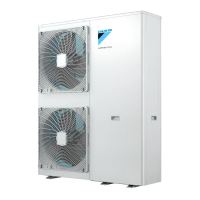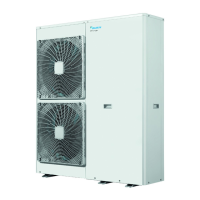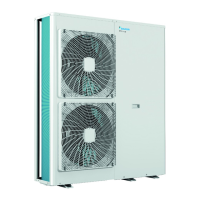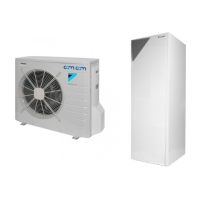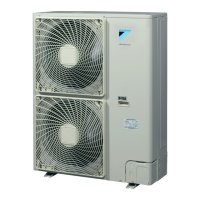5 Application guidelines
Installer reference guide
16
EBLQ+EDLQ011~016CAV3+W1 + EK(2)CB07CAV3 +
EKMBUHCA3V3+9W1
Daikin Altherma low temperature monobloc
4P522034-1 – 2018.01
▪ The space operation mode is sent by one digital output (X8M/6
and X8M/7) on control box EKCB07CAV3 to:
▪ The heatpump convectors
▪ The shut-off valve
Configuration
Setting Value
Unit temperature control:
▪ #: [A.2.1.7]
▪ Code: [C-07]
1 (Ext RT control): Unit operation
is decided by the external
thermostat.
Number of water temperature
zones:
▪ #: [A.2.1.8]
▪ Code: [7-02]
0 (1 LWT zone): Main
External room thermostat for the
main zone:
▪ #: [A.2.2.E.5]
▪ Code: [C-05]
1 (Thermo ON/OFF): When the
used external room thermostat or
heatpump convector can only
send a thermo ON/OFF
condition.
Benefits
▪ Cooling. Heat pump convectors provide, besides heating
capacity, also excellent cooling capacity.
▪ Efficiency. Under floor heating has the best performance with
Altherma LT.
▪ Comfort. The combination of the two heat emitter types provides:
▪ The excellent heating comfort of the underfloor heating
▪ The excellent cooling comfort of the heatpump convectors
5.2.2 Multiple rooms – OneLWT zone
If only one leaving water temperature zone is needed because the
design leaving water temperature of all heat emitters is the same,
you do NOT need a mixing valve station (cost effective).
Example: If the heat pump system is used to heat up one floor
where all the rooms have the same heat emitters.
Underfloor heating or radiators – Thermostatic
valves
If you are heating up rooms with underfloor heating or radiators, a
very common way is to control the temperature of the main room by
using a thermostat (this can either be the user interface connected to
control box EKCB07CAV3, or an external room thermostat), while
the other rooms are controlled by so-called thermostatic valves (field
supply), which open or close depending on the room temperature.
Setup
A Main leaving water temperature zone
B Room 1
C Room 2
a User interface
b Control box
c Backup heater (option)
▪ The underfloor heating of the main room is directly connected to
the outdoor unit – or to the backup heater, if there is one.
▪ The room temperature of the main room is controlled by the user
interface used as thermostat.
▪ A thermostatic valve is installed before the under floor heating in
each of the other rooms.
INFORMATION
Mind situations where the main room can be heated by
another heating source. Example: Fireplaces.
Configuration
Setting Value
Unit temperature control:
▪ #: [A.2.1.7]
▪ Code: [C-07]
2 (RT control): Unit operation is
decided based on the ambient
temperature of the user interface.
Number of water temperature
zones:
▪ #: [A.2.1.8]
▪ Code: [7-02]
0 (1 LWT zone): Main
Benefits
▪ Cost effective. You do NOT need an additional external room
thermostat.
▪ Easy. Same installation as for one room, but with thermostatic
valves.
Underfloor heating or radiators – Multiple external
room thermostats
Setup
A Main leaving water temperature zone
B Room 1
C Room 2
a User interface
b Control box
c Backup heater (option)
d Bypass valve
e External room thermostat
▪ For each room, a shut-off valve (field supplied) is installed to avoid
leaving water supply when there is no heating or cooling demand.
▪ A bypass valve must be installed to make water recirculation
possible when all shut-off valves are closed. To guarantee reliable
operation, provide a minimum water flow as described in table "To
check the water volume and flow rate" in "6.3 Preparing water
piping"on page26.
▪ The main user interface (connected to control box EKCB07CAV3)
decides the space operation mode. Mind that the space operation
mode of the additional user interfaces (used as room thermostat)
must be set to match that of the main user interface.
▪ The room thermostats are connected to the shut-off valves, and
do NOT have to be connected to the outdoor unit. The outdoor
unit will supply leaving water all the time, with the possibility to
program a leaving water schedule.
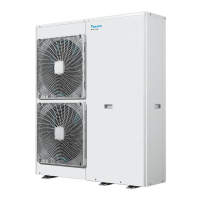
